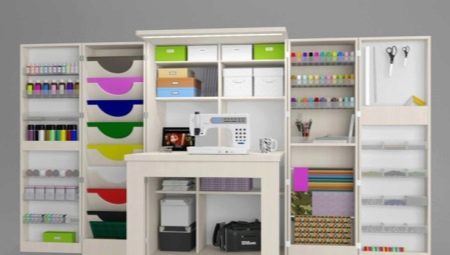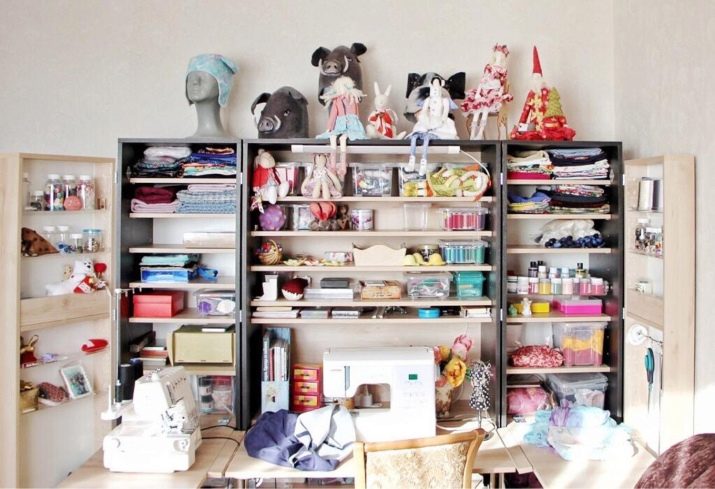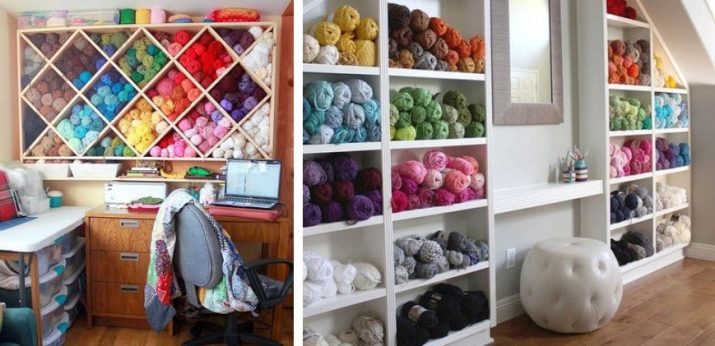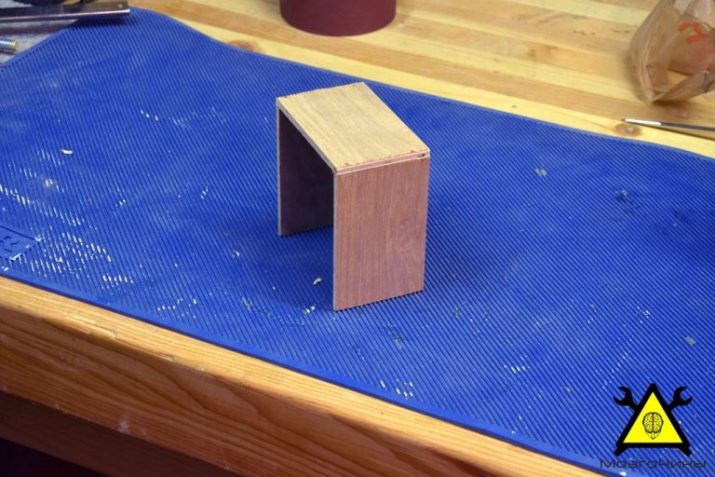All about handicraft cabinets

A person who loves and knows how to do beautiful things with his own hands is worthy of respect. But in a family with such needlework, there are only problems - knitting needles, fabrics, threads, ribbons can be found in any room in the most unexpected place. To get the job done, you need to look for a place where you can settle down with a lot of little things, without disturbing anyone. The best way out in this situation would be to purchase a special cabinet for needlework.
If you choose a model with a folding table, a stable workplace will be provided.

Description and purpose
A handicraft cabinet is a huge organizer with a large number of shelves, small drawers, all kinds of fasteners, which are located not only in the cabinet cavity, but also on swing doors. If the furniture is fully opened, it has an impressive storage area.

Most often, wardrobes are equipped with tables, which, at the end of the work, are hidden inside the furniture. They are extracted in different ways.
- The fold-out table top in a closed cabinet is in an upright position. When the doors are opened, the surface is lowered horizontally and rests on the legs.

- The table top slides out of the cabinet along with sewing or knitting equipment.

- Built-in wardrobes can have mobile units on casterswhose surfaces are used instead of tables.

- They produce furniture for creativity and with large countertops (table-wardrobe), on which you can make a cut of the material.

Depending on the type of hobby, designs may contain different storage locations.
But for many types of activity, universal models are suitable.

Seamstress's corner
Such furniture contains a work surface, a place for sewing equipment, comfortable shelves for fabrics. Hooks for bobbins, small boxes for storing buttons, and a lot of boxes and shelves for finishing, accessories, sewing tools, patterns, fashion magazines are provided.

Knitting furniture
If the needlewoman's collection contains several hundred balls of yarn, it is difficult to find the right threads without spending a lot of time on it. Special cabinets will help to organize the accumulated yarn. The shelves in them are made shallow, for the thickness of one skein. For ease of use, the doors are not installed. Products are laid in sections, forming them in color.

The examples presented show how a hanging cabinet or a structure built into the wall of the attic looks like. The rack is quickly assembled from ordinary plywood boxes, and it looks quite attractive together with the yarn.

Wood cabinet
Those who like to burn wood or carve patterns on objects also need a wardrobe. This hobby may require materials and tools no less than sewing. The work is dusty, so the furniture is installed in the country, on the balcony, in the garage, shed, workshop. Open cabinets have many shelves, drawers, small sections for chisels, files, screwdrivers. Perforated walls are used to store fasteners.

Universal models
There are many types of handicrafts for which universal wardrobes are suitable. Shelves, boxes, boxes, hooks, all kinds of niches and accessories can be useful for various types of creativity.
-
Knitting of flowers, souvenirs, decor for the interior.
-
Amigurumi - knitting tiny toys.
-
Quilling - the result of handicrafts is openwork appliques made of twisted spirals of lace, ribbons, threads and other material.
-
Embroidery with threads, beads.
-
Macrame - weaving from pots, wall decor, rugs.
-
Ganutel - work with wire and threads, as a result of which airy lace flowers, jewelry, souvenirs are obtained.
-
Yarnbombing - knitting for outdoor objects (poles, benches) of designer clothes.





We have cited only a small part of the hobbies that need systematized, well-equipped furniture to help.
What are they?
The sizes and types of cabinets depend on the space available for them in the room, as well as on the amount of accumulated handicraft material. Most of the designs belong to the transformer models, which, when opened, unfold into a full-fledged workplace, and then turn into ordinary furniture. Cabinets come in different types.
Floor
Cabinets installed on the floor surface can be as high as the ceiling and contain a large number of necessary things.
Outwardly, they look like ordinary furniture, but in the open form, a whole workshop with hundreds of storage places appears.

In a small space of a room, miniature low lockers on casters with many drawers are used. The upper part can form a folding system of compartments. This design is easy to transport around the room to the place of work.
Suspension
This option is suitable for small rooms in which there is only enough space for specialized furniture on the wall. Hinged products look different.
- In the form of narrow drawers with many sections located above the work table of the needlewoman.

- If a narrow structure is fixed on the wall not high from the floor, it can be a small folding table. After work, all departments, along with the table top, hide in a barely visible drawer and take up almost no space.

- For very cramped conditions, a thin but very functional cabinet was invented, suspended on the door leaf. Opening it, you can get a double number of storage places - in the drawer and on its door.

Desktop
This type of cabinet is appropriate if you have a large table with enough space for work and compact table furniture. It contains few storage places, so it is suitable for beginner craftswomen or for professionals who, in addition to the main cabinets, have a quick access model.


How to do it yourself?
Those who are not satisfied with the factory options for cabinets can make a structure with their own hands. Only in this case will you get furniture that is fully designed for a specific set of tools and materials intended for a specific handicraft.

You should start work by choosing a place. Then it is necessary to make a drawing that will allow the cabinet to accurately fit into the area allocated for it.
Every detail of the structure is thought over, calculated and applied to the diagram.
Tools and materials
Before starting work, you need to stock up on the necessary material, tools and prepare the workplace. To make a locker you will need:
-
plywood sheet;
-
acrylic sheet;
-
12 mm dowels;
-
jigsaw;
-
chisel;
-
ruler, tape measure;
-
pencil;
-
wood glue

Technology
When the diagram is drawn up and everything is prepared, you can get to work. The process consists of several stages.
- The plywood sheet is dissolved into uniform strips 6.5 cm wide.

- They make grooves 3 mm from the edge, they will serve as guides for the drawers.

- The boxes are endowed with the same depth - 10 cm, but different widths - 6, 8, 11, 12 cm, therefore, their bottom is made differently.

- Before assembly, all the parts are laid out in size - this makes it possible to understand what elements are missing, and cut them out in time.

- Collect the containers with wood glue, fix with small shoe nails.

- The front of each box is sanded.

- With the help of glue, spikes are installed on each box.

- We pass on to the implementation of the basic foundation. The size of the fixing board is selected as required. Clamps for the spikes are attached to it.

- Acrylic inserts are cut into each box, slightly larger than the boxes themselves, and glued to the front side.

- To facilitate the use of the drawers, small handles made of 12 mm dowels are attached to the facades.

- The basic shield is fixed to the wall and then filled with boxes.

The result is a compact but functional hanging cabinet.

Consider the benefits and functionality of a handicraft cabinet in the next video.








